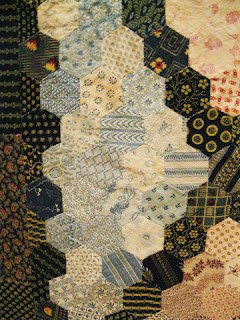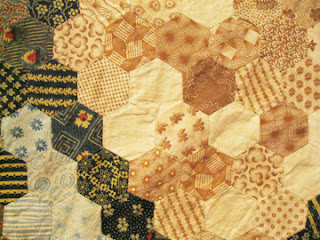Elegant Geometry Curated by Bridget Long
Hexagon mosaic, maker unknown
Probably made in United Kingdom, 1810-1830
108" x 106" IQSC 2006.056.0002
Gift of Clyde E. and Joan B. Shorey
But it's the closeup view that makes it's spectacular. The maker sorted her fabrics carefully, creating areas of dark prints framing areas of light. She had an exceptionally diverse scrapbag, but diverse in a narrow category of prints---monochrome prints in blue, pink and brown.
These finely detailed florals and geometrics
are calicoes printed with the latest roller printing technology---
up to date in 1820.
The top was full of excentric prints.
A proud printer testifying to the British Parliament in 1840 described these prints as "a particular style of design known by the name of 'excentrics,' in the production of which England surpasses every other nation in the world." Excentric prints (eccentric in American spelling) are fine geometric figures with jagged or wavy distortions.
Detail of the classic eccentric Lane's Net
from an American quilt about 1870
Lane's Net is a specific eccentric print style with many variations.
This top has more variations of Lane's Net than any I've seen.
The calico printer in 1840 described the invention of excentrics as an accident that occurred when a parallel stripe creased in the roller, "producing a new and unexpected effect. " Rather than discarding the misprint, he said, the enterprising mill owner (Mr. Lane?) was inspired to create a new fad for jagged stripes.
This version of accidental invention tends to be the origin story today (I've published it in my books). But the more I learn the more I doubt the tale. Eccentric prints were probably based less on accident and more on technological advances in lathes and other metal tools.
The word excentric means odd or erratic (off-center) but it also refers to geometric ellipses and circles with centers at different points (as opposed to concentric circles.)
Drawing using excentric line
The word excentric means odd or erratic (off-center) but it also refers to geometric ellipses and circles with centers at different points (as opposed to concentric circles.)
Bank note engraving making use of excentric curved lines
Toolmakers developed metal lathes with so-called excentric chucks that could create mechanical drawings of endless intricate line pattern, first used to engrave unforgeable bank note backgrounds. The English calico printers co-opted the technology as well as the name "excentric."
Three eccentric prints making use of curves and straight lines
The name eccentric came to mean any geometric print with intricate line pattern.
Late-19th-century scraps of Lane's Net, named for the mill owner
Look for variations on Lane's Net throughout the 19th century. It makes a great print collection focus. As far as the earliest date: The calico printer said in 1840 that the design originated 30 years ago, so 1810 is a good starting point. I've seen Lane's Net into the 20th century and variations have been reproduced in the last 20 years.
Here's another excuse to visit Lincoln. There will be a lecture at IQSC on Tuesday October 25 at noon.
“The Art and Science of Patchwork Tessellations”,
Dr. Barbara Caron, IQSCM Assistant Director.
Dr. Barbara Caron, IQSCM Assistant Director.
See more about the exhibit here:
And buy the catalog online here (It's sold only through the museum.)
The catalog is great, full of wonderful details, but if you want to see all the closeups you have to see the show. Photography without flash is permitted.
Read an 1841 essay on copyright in design that mentions Lane's Net by clicking here
















Wow! Thanks for sharing. I hope we'll get to see more photos.
ReplyDeleteYour wonderful close-ups are such a great learning tool for teaching us us about eccentric Lane's Net. Thank you!!! Now that I know, I'll know what to look for in old quilts.
ReplyDeleteThat is a beautiful piece to showcase the various fabrics during that time, love it.
ReplyDeleteDebbie
Barbara - What a wonderful and informative post!! I can see why your fabric designs are so authentic!! Thanks for the tutorial!! Kris
ReplyDeletethose fabrics are beautiful! the information is so interesting and, as always, inspiring. thank you
ReplyDelete